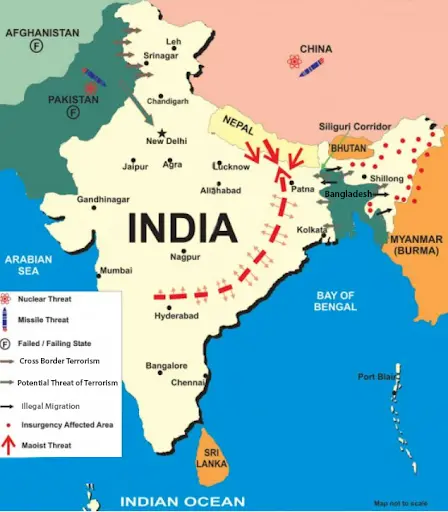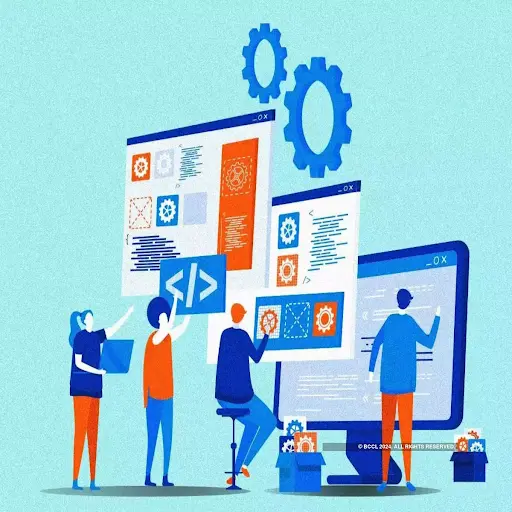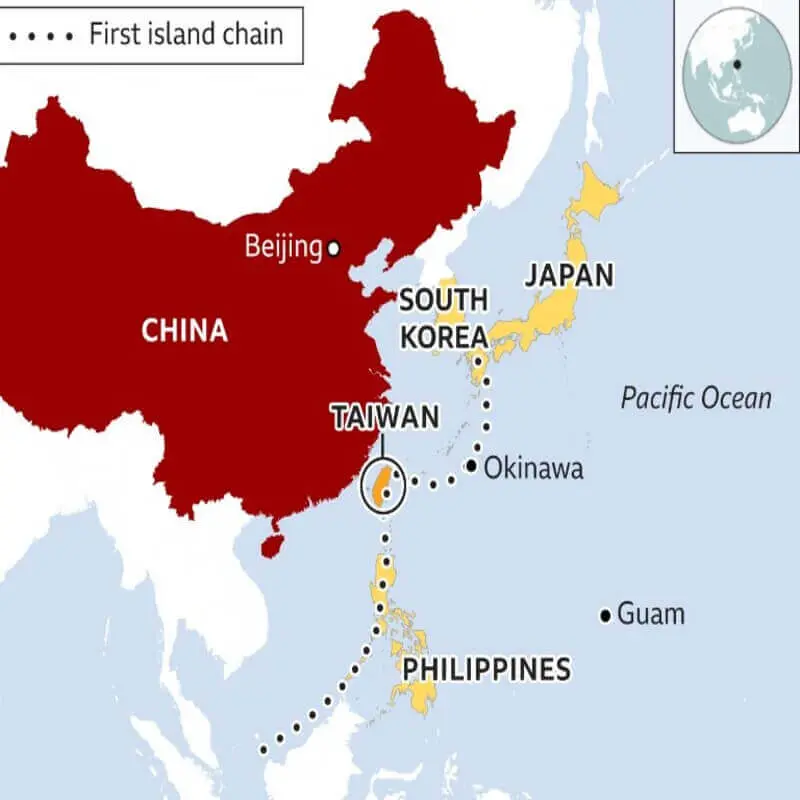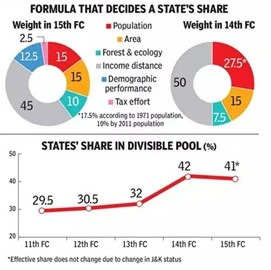Wednesday, 19th June 2024
Time for india Census
Why in the news?
- The 2021 Census has been delayed for so long because the Bharatiya Janata Party (BJP) is delaying the Census because it wants to fast-track the “delimitation” exercise in anticipation of the 2029 Lok Sabha elections.
The 84th Amendment of the Constitution:
- The 84th Amendment of the Constitution mandates that the next delimitation exercise must be based on the first census conducted after 2026.
- Delimitation will be postponed until after the subsequent census in the 2030s if the next census occurs before 2026.
- Delimitation aims to adjust the allocation of Lok Sabha seats among states to align with their population shares and ensure equitable representation across constituencies.
- The upcoming delimitation is anticipated to benefit northern states that have experienced rapid population growth since 1973, possibly resulting in a redistribution of seats that could disadvantage southern states.
About the 106th Amendment:
- Background: The 106th Amendment was passed in 2019 and received presidential assent in January 2020.
- Increase in Reservation: The amendment extends the reservation of seats in the Lok Sabha and state legislatures for another 10 years, up to January 25, 2030. This provision was set to expire in January 2020 before the amendment was passed.
- Constitutional Provisions: Article 330 deals with reservation of seats for SCs and STs in the Lok Sabha, while Article 332 deals with similar reservation in state legislative assemblies.
- Women’s Reservation: Passed in September 2023, this amendment mandates one-third reservation of seats for women in the Lok Sabha and State Assemblies.
- Implementation Clause: The reservation will be implemented after delimitation is conducted based on the first census figures post-2023.
- Separate Delimitation: The amendment suggests a separate delimitation process may be initiated specifically for implementing women’s reservation.
- Interpretation: This provision allows for the possibility of initiating women’s reservation based on an early census, independent of the broader delimitation exercise mandated by the 84th Amendment.
Overall Implications:
- Impact on Southern States:
- Seat Redistribution: Delimitation may transfer more Lok Sabha seats to northern states, potentially reducing southern states' representation.
- Political Tensions: This shift could provoke regional tensions and increase opposition to the BJP in southern states.
- Women’s Reservation:
- Implementation Delay: Delaying the census could postpone the implementation of the 106th amendment, which reserves one-third of seats for women.
- Separate Delimitation: Women’s reservation may be initiated through a separate delimitation process, distinct from the broader exercise mandated by the 84th Amendment.
- Welfare and Entitlements:
- Updated Data Requirement: Census data are essential for implementing welfare schemes and ensuring equitable resource allocation.
- Impact on Beneficiaries: A delayed census could deprive millions of updated entitlements like food rations under the National Food Security Act, affecting their access to essential services.
Way forward:
- Timely Census Completion:
- Conduct the 2021 Census promptly to obtain accurate population data.
- Ensure timely completion to support effective implementation of welfare schemes and equitable resource allocation.
- Facilitate access to essential services for millions of citizens reliant on updated population figures.
- Separate Delimitation for Women’s Reservation:
- Implement women’s reservation through a distinct delimitation exercise, as permitted by the 106th Amendment.
- Allow women’s reservation to take effect independently of the broader delimitation mandated by the 84th Amendment.
- Expedite the process to realise gender parity in legislative bodies without delay.
|
UPSC Civil Services Examination, Previous Years Question (PYQ) Q:1 Consider the following statements: (2009)
Which of the statements given above is/are correct?
Ans: (d) Mains Q:1 Empowering women is the key to controlling population growth.” Discuss. (2019) |
Source:TH
Monsoon in India
Why in the news ?
- The southwest monsoon arrived early in Kerala and has progressed up to Maharashtra, while North and Northwest India continue to face 'heatwave' to 'severe heatwave' conditions.
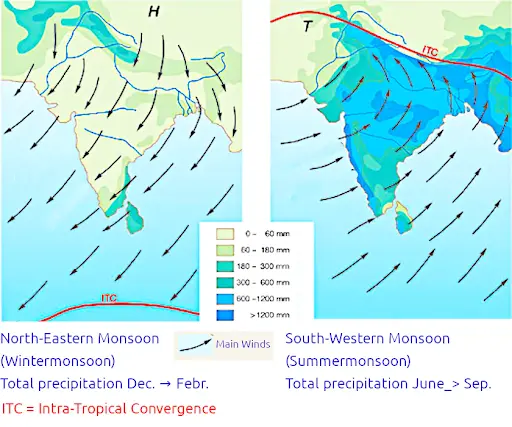
About the monsoon:
- The term ‘monsoon’ originates from the Arabic word ‘mausim’, meaning season, referring to the seasonal reversal of wind direction.
- The onset and retreat of the monsoon significantly impact India's climate, agriculture, and economy.
Monsoon Onset(Arrival):
- Traditionally, the monsoon arrives over the Andaman Sea by the third week of May and progresses into the mainland, typically reaching Kerala around June 1.
- During the summer months (June to September), winds blow from the South-West, delivering more than 70% of India’s annual rainfall.
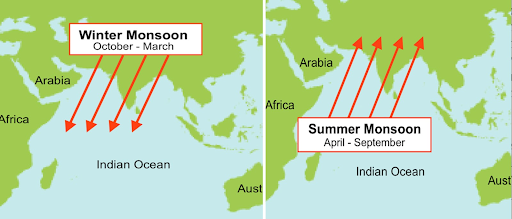
- The northward shift of the Inter-Tropical Convergence Zone (ITCZ) triggers the onset of monsoon rains.
- The monsoon trough fosters the formation of a thermal low over north and northwest India.
- The IMD declares the monsoon's onset based on defined criteria, including rainfall patterns, wind conditions, and Outgoing Longwave Radiation (OLR) levels.
Monsoon Progress:
- Following its onset over Kerala, the monsoon moves northward and typically covers the entire country within approximately six weeks.
- Its progression accelerates until central India before slowing down.
- By the end of June, it usually reaches north Uttar Pradesh, Delhi, and neighbouring areas, achieving national coverage by July 15th. This timing is critical for kharif crop sowing.
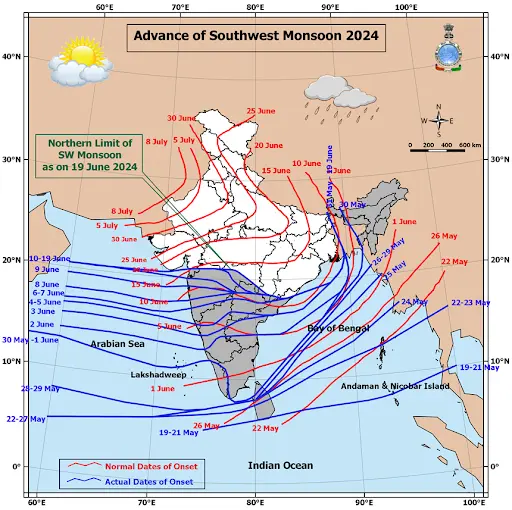
Monsoon Retreat (Withdrawal):
- The monsoon's retreat signifies the shift from the rainy season to dry winter conditions. Starting in early September, it begins withdrawing from northwestern India, completing its retreat by early October.
- Unlike its onset, the withdrawal is gradual, with the monsoon lingering over southern and northeastern regions well into October.
Monsoon Variability:
- Onset, Advancement, and Withdrawal: The timing and duration of the monsoon influence rainfall patterns in different regions.
- Position of Monsoon Trough: The monsoon trough's location can shift up to 5° north or south within 24 hours. Its southern position enhances monsoon activity over India, while a northern or absent trough can lead to breaks in monsoon conditions.
- Synoptic Systems: Cyclonic circulations, lows, and depressions moving along the troughs contribute to rainfall distribution.
Periodicity of Monsoon:
- The year-to-year variation in monsoon rainfall over many years is known as interannual variability.
- Global ocean-atmospheric phenomena like El Niño Southern Oscillation (ENSO) and Indian Ocean Dipole (IOD) primarily influence the monsoon's periodicity.
- Additional factors include the North Atlantic Oscillation (NAO) and Pacific Decadal Oscillations (PDO
H5N1 threat for humans
Why in the news?
- Recently, the spread of highly pathogenic avian influenza (HPAI) H5N1 to cattle and the first human cases among U.S. dairy workers have intensified concerns about broader human transmission.
Highly pathogenic avian influenza H5N1 strain spread from cattle to humans:
- Recent Infections: Three cases of human infection in dairy farm workers were reported in the U.S., indicating the potential for the virus to spread from cattle to humans.
- Transmission: The virus seems to spread to humans who have close interactions with infected birds or animals without adequate personal protection.
- Current Risk Level: Scientists note that the virus currently lacks the mutations necessary for efficient human-to-human transmission, maintaining a low risk to human health. However, the potential for the virus to rapidly evolve remains a significant concern.
Strategy to Identify and Contain the Spread of the Virus:
- Surveillance in Kerala:
- Community-Based Disease Surveillance Network: Kerala has implemented a network involving 2.5 lakh volunteers trained in the ‘One Health’ concept across four districts: Alappuzha, Pathanamthitta, Kottayam, and Idukki.
- Early Warning System: Volunteers report any unusual events or deaths of animals/birds in their locality, enabling early warning and prompt preventive or control measures.
- Global Coordination:
- Call for Robust Response: A recent editorial by The Lancet emphasises the need for a robust and coordinated global response to H5N1.
- ‘One Health’ Concept:
- Interconnection: ‘One Health’ recognizes the interconnection between people, animals, plants, and their shared environment.
- Collaborative Efforts: It emphasises the need for collaborative efforts across different sectors to achieve optimal health outcomes.
- Implementation in Kerala:
- Operationalizing ‘One Health’: Kerala uses the ‘One Health’ concept through the World Bank-aided ‘Rebuild Kerala’ project. This involves a community-based disease surveillance network where volunteers monitor and report on animal and bird health, ensuring early detection and response to potential outbreaks.
- Proactive Measures: The state has established an on-ground, volunteer-driven network for disease monitoring and control, taking proactive steps beyond the conceptual framework.
Way Forward:
- Strengthen Global Surveillance and Collaboration:
- International Cooperation: Enhance cooperation for surveillance, data sharing, and rapid response mechanisms.
- ‘One Health’ Approach: Leverage the ‘One Health’ approach for coordinated action across human, animal, and environmental health sectors.
- Implement Rigorous Biosecurity and Safety Protocols:
- Biosecurity Measures: Ensure strict biosecurity measures for workers in close contact with animals, particularly in high-risk areas.
- Personal Protective Equipment (PPE): Provide and enforce the use of PPE to prevent zoonotic transmission and reduce the potential for human infections.
|
UPSC Civil Services Examination PYQ Mains PYQ: Q:1 The public health system has limitations in providing universal health coverage. Do you think that the private sector can help in bridging the gap? What other viable alternatives do you suggest? (2015) |
Source: TH
Pro-Tem Speaker of Lok Sabha
Why in the News?
- The first session of the 18th Lok Sabha is set to convene soon. Until the election of the new Speaker, a pro-tem Speaker will be appointed to administer the oath to the newly elected Members of Parliament.
Who is a Pro-tem Speaker?
- Role of the Lok Sabha Speaker: The Speaker of the Lok Sabha manages the daily proceedings of the House.
- Outgoing Speaker's Tenure: According to Article 94 of the Indian Constitution, the outgoing Speaker remains in office until the first meeting of the new Lok Sabha.
- Temporary Appointment: A pro-tem Speaker is appointed temporarily to handle specific duties until the new Speaker is elected.
- Constitutional Mention: The Constitution does not explicitly mention the post of pro-tem Speaker.
- Guidelines: The ‘Handbook on the Working of the Ministry of Parliamentary Affairs’ provides guidelines on the appointment and duties of the Speaker pro-tem.
- Administering Oaths: The primary duty of the pro-tem Speaker is to administer oaths to new MPs, as required by Article 99 of the Constitution.
Appointment of the Pro-tem Speaker:
- Presidential Appointment: When the Speaker’s post is vacant before the new Lok Sabha convenes, the President appoints a Member of the House as the Speaker pro-tem.
- Oath Administration: The President administers the oath to the Speaker pro-tem at the Rashtrapati Bhawan.
- Assistants in Oath-taking: Generally, three other elected members of the Lok Sabha are also appointed by the President to assist in the oath-taking process.
- Selection Criteria: The senior most members, in terms of years of service, are usually chosen for this role, though exceptions can occur.
Process of Administering Oaths:
- Preparation of Senior Members List: The Legislative I Section of the Government of India prepares a list of the seniormost Lok Sabha members after the formation of the new government.
- Identification of Speaker Pro-tem: This list is submitted to the Minister of Parliamentary Affairs or the Prime Minister, who identifies the Speaker pro-tem and the three other members for oath-taking.
- Approval and Consent: After the Prime Minister’s approval, the consent of the selected members is obtained by the Minister of Parliamentary Affairs, usually over the telephone.
- Submission to the President: The Minister then submits a note to the President seeking approval for the appointments and the date and time for the swearing-in ceremony.
- Notification of Appointments: Upon the President’s approval, the Ministry informs the Speaker pro-tem and the other members about their appointments.
- Oath Administration: The Speaker pro-tem then administers the oath to the other three members in the Lok Sabha.
|
UPSC Civil Services Examination, Previous Year Questions (PYQs) Prelims Q:1 With reference to Deputy Speaker of Lok Sabha, consider the following statements: (2022)
Which of the statements given above are correct?
Ans: (b) Q:2 With reference to the Speaker of the Lok Sabha, consider the following statements : While any resolution for the removal of the Speaker of the Lok Sabha is under consideration
Which of the statements given above is/are correct?
Answer: A Mains: Q:1 To what extent, in your view, the Parliament is able to ensure accountability of the executive in India? (2021) Q:2 How far do you think cooperation, competition and confrontation have shaped the nature of federation in India? Cite some recent examples to validate your answer. (2020) |
Souce: IE
Tamil Nadu Seeks GI Tag for Seven Agricultural Products
Why in the news ?
- The Tamil Nadu State Agricultural Marketing Board has filed applications for Geographical Indication (GI) tags for seven agricultural products from the state.
- The application process was facilitated by the NABARD-Madurai Agribusiness Incubation Forum (MABIF).

Products seeking GI Tag:
- Senganthal Seed: Senganthal seed is a traditional paddy variety from Tamil Nadu, prized for its drought resistance and adaptability to local soil conditions. It is known for producing nutritious rice with a unique flavour, and is often cultivated using organic farming practices.
- Kolli Hills Pepper: Kolli Hills pepper is cultivated in the Kolli Hills region of Tamil Nadu. It is renowned for its robust flavour and pungency. This pepper is organically grown by tribal farmers and holds a significant place in both domestic and international spice markets.
- Ayyampalayam Nettai Thennai: Ayyampalayam Nettai Thennai refers to a tall coconut variety from Ayyampalayam, Tamil Nadu. Known for its high yield, these coconuts are rich in water and meat, making them ideal for both culinary uses and copra production.
- Tirunelveli Senna Leaf : Tirunelveli Senna leaf is a medicinal plant grown in Tirunelveli, Tamil Nadu. It is widely used for its natural laxative properties. The leaves contain compounds like sennosides, which are effective in treating constipation and are exported globally for pharmaceutical use.
- Sathyamangalam Red Banana: Sathyamangalam red banana is a rare banana variety from Sathyamangalam, Tamil Nadu. Characterised by its reddish skin and sweet, creamy flesh, it is not only a local delicacy but also rich in nutrients like vitamin C and beta-carotene.
- Urigam Puli: Urigam puli is a variety of tamarind known for its rich, tangy flavour. Cultivated in the Urigam region, Tamil Nadu, it is a key ingredient in South Indian cuisine, especially in dishes like sambar and rasam. It is also valued for its antioxidant properties.
- Odaipatti Seedless Grapes : Odaipatti seedless grapes are grown in the Odaipatti region of Tamil Nadu. These grapes are noted for their sweet, juicy flavour and are popular both as fresh fruit and in wine production. They are a significant agricultural product, contributing to the local economy
|
What is a Geographical Indication (GI) Tag? About:
Legal Framework and Obligations:
|
|
UPSC Civil Services Examination, Previous Year Questions (PYQs) Pelims Q1. Which of the following has/have been accorded ‘Geographical Indication’ status? (2015)
Select the correct answer using the code given below:
Ans: (c) Q:2. India enacted the Geographical Indications of Goods (Registration and Protection) Act, 1999 in order to comply with the obligations to (2018) (a) ILO (b) IMF (c) UNCTAD (d) WTO Ans: (d) |
Source: (TH)
Filoboletus manipularis
Why in the news ?
- Recently, researchers have discovered a rare species of bioluminescent mushrooms in Kasargod that emit a brilliant, otherworldly green light in the darkness of night.

- The fungi, scientifically known as Filoboletus manipularis, are capable of producing their own light through a biochemical process in their cells.
- Bioluminescence in these mushrooms is attributed to a chemical reaction involving luciferin (a pigment) and luciferase (an enzyme), substances that produce light when combined with oxygen.
- The natural glow emitted by these mushrooms is believed to attract insects, facilitating the dispersal of spores and contributing to the fungi’s reproductive cycle.
- They thrive in tropical, humid environments, typically found in dense forests with abundant decaying organic matter, like fallen trees and leaves, as it provides the nutrients and conditions necessary for their growth and their unique glowing property.
- These mushrooms are not fit for consumption as the chemicals that make them glow could be toxic, leading to severe gastrointestinal issues.
Source: IE
Krishi Sakhis
Why in the news ?
- The Prime Minister granted certificates to more than 30,000 women from Self Help Groups (SHGs) as Krishi Sakhis.
- This certification course aligns with the objectives of the ‘Lakhpati Didi’ Program.
About KSCP:
- The Krishi Sakhi Convergence Program (KSCP) aims to transform rural India by empowering rural women as Krishi Sakhi by imparting training and certification of Krishi Sakhi as Para-extension Workers.
- This initiative aims to create three crore Lakhpati Didis by training and certifying women as Krishi Sakhis, thereby enhancing their agricultural skills and providing new employment opportunities.
- This initiative, supported by the Ministry of Agriculture and Farmers Welfare and the Ministry of Rural Development, aims to improve rural livelihoods and standards of living.
- Krishi Sakhi is envisaged to create awareness and capacity building in the community regarding agricultural activities and facilitate the aggregation and marketing of agricultural products.
- Krishi Sakhis are chosen as agriculture para-extension workers because they are trusted community resource persons and experienced farmers. Their deep roots in farming communities ensure they are welcomed and respected.
Women Workforce in Agriculture Sector:
- Agriculture employs approximately 80% of rural women, according to NITI Aayog.
- The percentage of female operational holdings has risen from 12.78% in 2010-11 to 13.78% in 2015-16.
- Significance:
- Women are responsible for producing 60-80% of the country's food.
- The ratio of women to men working in agriculture has increased, contributing more significantly to GDP per capita.
- Women's leadership in agriculture can effectively address and reduce gender inequality
The kind of training provided:
- Agro Ecological Practices from land preparation to harvest
- Organising Farmer Field schools
- Seed banks establishment and management
- Soil health, soil and moisture conservation practices
- Integrated Farming Systems
- Basics of Livestock Management
- Preparation and use of Bio inputs and establishment of Bio inputs shops
- Basic communication skills
|
Government Schemes for Women Farmers:
|
Source: PIB
U.S.-India Initiative on Critical and Emerging Technology
Why in the news ?
- Recently, the Initiative on Critical and Emerging Technologies (iCET), led by the Indian National Security Council Secretariat and the U.S. National Security Council was launched in 2023.
- It is a framework for cooperation on critical and emerging technologies (CET) in areas including space, semiconductors, telecommunications, clean energy, biotechnology, etc.
|
Significance of ICET
|
Key Highlights:
- Innovation:
- Funding: Unlock over $90 million in government funding over the next five years for the U.S.-India Global Challenges Institute to foster research partnerships in areas like semiconductor technology and sustainable agriculture.
- Space Technology Cooperation:
- NASA-ISRO Collaboration: Launch NASA-ISRO Synthetic Aperture Radar, a jointly developed satellite to map Earth's surface twice every 12 days, aiding climate change efforts.
- Lunar Gateway Programme: Explore opportunities to participate in the Lunar Gateway Programme (LGP), aiming to build a space station around the moon as part of the collaborative Artemis programme led by the U.S.
- Telecommunications:
- Open RAN: Partnerships to deploy cost-effective Open Radio Access Network technology.
- 6G Technologies: Strengthen cooperation in 6G technologies.
- Biotechnology:
- Strategic Framework: Developing a joint strategic framework for optimising and strengthening the global biopharmaceutical supply chain.
- Bio-X Initiative: Launch of the “Bio-X” initiative to promote cooperation in biotechnology and enhance the competitiveness of biotechnology industries.
- Clean Energy:
- Mineral Security: Enhancing mineral security partnership through co-investment in a lithium resource project in South America and rare earths deposit in Africa
|
National Security Council:
Composition of the NSC:
National Security Advisor:
Members of NSC:
Functions of NSC:
|
Source: AIR
World Lagging on Sustainable Development Goals
Conext:
- The recent UN report by the Sustainable Development Solutions Network (SDSN) highlights a pivotal moment in global efforts to achieve the Sustainable Development Goals (SDGs) by 2030.
- The report paints a grim picture, indicating that none of the 17 goals are on track, emphasising the critical need for immediate and comprehensive reforms.
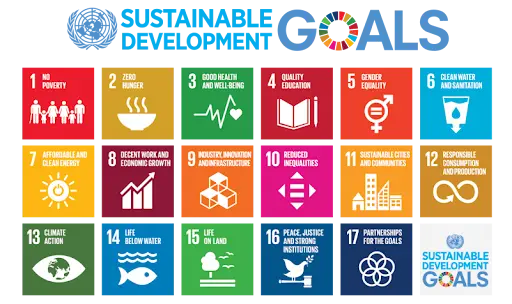
Importance of SDGs:
The Sustainable Development Goals (SDGs), established by the United Nations in 2015, serve as a universal call to action to address various global challenges by 2030.
- Poverty Eradication: SDGs strive to eradicate poverty in all its forms and ensure access to basic necessities like food, water, shelter, and healthcare for everyone.
- Environmental Protection: They tackle critical environmental issues such as climate change, biodiversity loss, and pollution, promoting sustainable practices for conserving natural resources and reducing environmental degradation.
- Social Inclusion: SDGs promote equality and inclusion by addressing gender inequality, discrimination, and social exclusion. They aim to ensure equal opportunities and access to resources for all individuals.
- Economic Growth: SDGs emphasise sustainable economic growth that is inclusive and equitable, creating jobs, fostering innovation, and building resilient economies.
- Global Partnership: They call for global cooperation between governments, businesses, civil society, and individuals to achieve the goals collectively and sustainably.
- Improved Health and Well-being: SDGs aim to ensure healthy lives and well-being for all, focusing on access to quality healthcare, nutrition, clean water, and sanitation.
- Reduced Inequalities: SDGs aim to reduce inequalities within and among countries, addressing disparities in income, wealth, opportunity, and access to resources
Progress and Challenges of SDGs:
- Stagnant Progress: Only 16% of SDG targets are advancing well, highlighting significant obstacles in policy implementation and achieving concrete results.
- Key Areas of Concern:
- Zero Hunger (SDG 2): Food insecurity and hunger are on the rise.
- Sustainable Cities and Communities (SDG 11): Issues with urban planning and inadequate infrastructure.
- Life Below Water (SDG 14) and Life on Land (SDG 15): Increasing biodiversity loss and environmental degradation.
- Peace, Justice, and Strong Institutions (SDG 16): Declining press freedom and a rise in conflicts pose challenges.
- Impact of COVID-19:
- SDG 3 (Good Health and Well-being): Life expectancy and health disparities worsened.
- Poverty Reduction and Education (Multiple SDGs): Setbacks in poverty reduction efforts and disruptions in education were observed
Leading and Lagging Nations in SDG Achievement:
- Nordic Countries: These nations continue to lead in achieving the SDGs, bolstered by strong social policies and environmental commitments that support sustainable development.
- BRICS and BRICS+ Countries: While showing progress, these countries are still lagging behind the leading nations in terms of SDG achievement. They face challenges in balancing economic growth with social and environmental sustainability.
- Least Developed Countries: These nations are experiencing significant setbacks in SDG attainment, widening the gap since 2015. They struggle with limited resources, weak infrastructure, and socio-economic disparities that hinder progress.
- Financial Architecture: Reforming global financial systems is crucial to provide low and middle-income countries with access to affordable, long-term capital. This reform is essential for investing in public goods such as education (SDG 4) and other critical sectors that support sustainable development goals
India’s Performance toward achieving various SDGs:
- Progress: India has made strides in poverty reduction, renewable energy adoption, economic growth, and gender equality under the Sustainable Development Goals (SDGs).
- Challenges: Persistent issues include addressing hunger, improving education quality, ensuring access to clean water, mitigating climate change impacts, and reducing inequality.
- Impactful Initiatives: Programs like PMAY, MGNREGA, PDS, Ayushman Bharat, and Swachh Bharat have shown positive results in their respective areas.
- Further Efforts Needed: Continued focus is required to achieve sustainable access to clean water, enhance educational standards, reduce healthcare disparities, and strengthen climate change resilience.
- Commitment to SDGs: India demonstrates strong commitment through various policies and programs aimed at achieving the SDGs.
- Key Areas for Improvement: Addressing infrastructure gaps, promoting technological innovation, tackling social inequalities, and fostering sustainable urban development are crucial for future progress.
- Collaborative Approach: Collaboration between government, private sector, and civil society is essential for accelerating progress towards achieving the SDGs by 2030.
Recommendations:
- Major Overhaul: The report advocates for a significant restructuring of current approaches, suggesting that maintaining the status quo will not be adequate. It proposes a UN 2.0 model aimed at enhancing global cooperation and effectiveness.
- Reforming Financial Systems: To generate necessary funds, the report recommends establishing new institutions and implementing global taxation schemes. It suggests prioritising investments in quality education and sustainable infrastructure.
- Multilateralism Index: Introducing a new index to measure countries' support for UN-based multilateralism underscores the importance of global cooperation. Countries that prioritise multilateralism tend to perform better on SDGs.
- Food and Land Systems: Addressing both undernutrition and rising obesity through sustainable agricultural practices is crucial, according to the report. It emphasises the need for integrated approaches to food and land systems.
- FABLE Pathways: Focusing on the Future of Agriculture, Biodiversity, Land-use, and Energy pathways, the report suggests:
- Reducing overconsumption and limiting animal-based protein.
- Investing in increasing productivity, especially in high-demand areas.
- Establishing inclusive and transparent monitoring systems to combat deforestation.
Conclusion:
The UN report calls for urgent and comprehensive action to achieve the SDGs, emphasising the necessity for robust global cooperation, substantial financial reforms, and innovative policy solutions. Addressing these challenges is essential for ensuring a sustainable and equitable future for all. The analysis underscores the interconnectedness of global issues and the importance of collective efforts in overcoming them
Source: EU
Share the article
Edukemy’s Current Affairs Quiz is published with multiple choice questions for UPSC exams
MCQ
Get Latest Updates on Offers, Event dates, and free Mentorship sessions.

Get in touch with our Expert Academic Counsellors 👋
FAQs
UPSC Daily Current Affairs focuses on learning current events on a daily basis. An aspirant needs to study regular and updated information about current events, news, and relevant topics that are important for UPSC aspirants. It covers national and international affairs, government policies, socio-economic issues, science and technology advancements, and more.
UPSC Daily Current Affairs provides aspirants with a concise and comprehensive overview of the latest happenings and developments across various fields. It helps aspirants stay updated with current affairs and provides them with valuable insights and analysis, which are essential for answering questions in the UPSC examinations. It enhances their knowledge, analytical skills, and ability to connect current affairs with the UPSC syllabus.
UPSC Daily Current Affairs covers a wide range of topics, including politics, economics, science and technology, environment, social issues, governance, international relations, and more. It offers news summaries, in-depth analyses, editorials, opinion pieces, and relevant study materials. It also provides practice questions and quizzes to help aspirants test their understanding of current affairs.
Edukemy's UPSC Daily Current Affairs can be accessed through:
- UPSC Daily Current Affairs can be accessed through Current Affairs tab at the top of the Main Page of Edukemy.
- Edukemy Mobile app: The Daily Current Affairs can also be access through Edukemy Mobile App.
- Social media: Follow Edukemy’s official social media accounts or pages that provide UPSC Daily Current Affairs updates, including Facebook, Twitter, or Telegram channels.

